Actionable Threat Intelligence – Boosting Attack Surface Management

Modern cybersecurity challenges require a comprehensive approach to attack surface management. As technology evolves, organizations find themselves facing a multitude of cyber threats from various directions. These threats are not limited to internal systems but extend across external attack surfaces and the digital supply chain. To navigate this complex threat landscape, organizations need more than just raw data; they need actionable threat intelligence that provides context and guides targeted action.
In this article
What Is Actionable Threat Intelligence?
Actionable threat intelligence refers to the process of collecting, analyzing, and leveraging data about potential threats in a manner that is both useful and meaningful for security teams. Unlike raw data, which often lacks context, actionable threat intelligence focuses on distilling information into insights that can guide decision-making and risk mitigation efforts.
The Value of Actionable Threat Intelligence
Actionable threat intelligence empowers organizations to not only understand the threat landscape but also take informed and targeted actions to mitigate risks and defend against potential cyberattacks. It offers specific, relevant, and timely information about emerging threats, attack techniques, and indicators of compromise (IOCs), enabling organizations to be proactive rather than reactive in their security posture.
By leveraging actionable threat intelligence, organizations can make informed decisions, prioritize resources, and implement effective security controls to reduce their overall risk exposure. This proactive approach minimizes the likelihood of successful attacks and the impact of potential breaches, allowing organizations to effectively manage risks and protect their critical assets.
Examples of Threat Intelligence
Threat intelligence covers a wide range of approaches to monitoring and analyzing potential threats and vulnerabilities. This intelligence can help organizations anticipate, mitigate, and respond to cyber threats effectively. Some examples of threat intelligence include the following:
- Monitoring Dark Web Activity:
By scanning the dark web for chatter about an organization’s sensitive information, upcoming attacks, or compromised credentials, security teams can anticipate and mitigate potential threats before they escalate. This intelligence allows for timely responses and contributes to overall risk reduction.
- Real-Time Malware Analysis:
Through actionable threat intelligence, organizations can receive real-time alerts on newly identified malware strains targeting specific industries or systems. By recognizing these threats early, security teams can deploy defenses, such as updated antivirus signatures and network filters, to prevent attacks and achieve risk reduction.
- Threat Actor Profiling:
Understanding the methods and motivations of specific threat actors can help organizations tailor their security measures. For instance, if threat intelligence indicates a particular group is targeting a specific type of software, security teams can apply patches or implement mitigations to decrease the risk of successful attacks.
- Identification of Exploitable Vulnerabilities:
Actionable threat intelligence can highlight software or hardware vulnerabilities being exploited by attackers. Organizations can prioritize patching these vulnerabilities to reduce their attack surface and achieve significant risk reduction.
- Supply Chain Risk
Monitoring: By tracking potential threats to third-party suppliers, such as software vulnerabilities or data breaches, organizations can take proactive measures to protect their digital supply chain and minimize the risks to their operations.
- Indicators of Compromise (IOCs):
IOCs are signs that an attack may be occurring or has already occurred. These can include specific file hashes, IP addresses, URLs, domain names, or patterns of network traffic associated with known attacks. Security teams can use these indicators to detect and respond to potential threats.
- Attack Surface Mapping:
Understanding an organization’s attack surface, including all internet-facing assets, is crucial for effective defense. Actionable threat intelligence can provide information on newly discovered assets, open ports, and misconfigurations that could be exploited by attackers. Attack Surface Mapping aims to find every asset an attacker might be able to compromise in order to gain access to your systems – by displaying these assets and their connections, you can more easily understand what you have, how those assets are connected, and what risks those connections might pose.
The Benefits of Actionable Threat Intelligence
Actionable threat intelligence is a critical tool for organizations looking to enhance their cybersecurity strategies. By providing real-time insights, threat intelligence allows organizations to take a proactive approach to risk management. Additionally, actionable threat intelligence offers benefits to organizations seeking to strengthen their cyber security posture and protect their digital assets. Benefits include: :
- Proactive Risk Mitigation:
By prioritizing and addressing risks based on the most relevant and current intelligence, organizations can proactively prevent or mitigate attacks before they cause damage.
- Enhanced Incident Response:
Actionable threat intelligence supports faster and more efficient incident response by providing context around ongoing attacks, helping security teams take appropriate action quickly.
- Improved Vulnerability Management:
By correlating threat intelligence with known vulnerabilities, organizations can prioritize patching and remediation efforts, focusing on the most critical vulnerabilities first.
- Efficient Threat Hunting:
Security teams can use actionable threat intelligence to proactively search for and investigate potential threats within their environments, improving their ability to detect and respond to attacks.
- Increased Visibility:
With a comprehensive view of the threat landscape, actionable threat intelligence enables organizations to grasp the entire range of potential risks and vulnerabilities within their digital ecosystem.
- Streamlined Remediation:
Actionable threat intelligence can provide clear guidance and recommendations for mitigating threats, simplifying the process for security teams and reducing the mean time to resolution (MTTR).
- Integration with Existing Tools:
Actionable threat intelligence can be integrated with existing security tools such as SIEM and SOAR systems, enhancing the effectiveness of these tools and streamlining security operations.
- Supports Compliance:
By providing detailed insights into threats and risks, actionable threat intelligence can help organizations meet regulatory and compliance requirements related to cyber security.
Enhancing Cyber Security Through Actionable Threat Intelligence (TI)
Actionable threat intelligence plays a key role in strengthening an organization’s cybersecurity defenses. By providing organizations with essential data,TI allows organizations to identify potential risks before they become major security incidents. Threat intelligence can also serve several additional purposes in an organization’s cyber security strategy. Some uses of actionable threat intelligence include:
- Proactive Threat Detection:
By leveraging threat intelligence, organizations can detect potential threats before they are exploited, allowing for proactive measures such as patching vulnerabilities and strengthening security controls.
- Timely Incident Response:
Integrating actionable threat intelligence into incident response processes accelerates decision-making and allows security teams to prioritize and escalate incidents based on the severity and relevance of the threat.
- Improved Vulnerability Management:
Organizations can align threat intelligence with vulnerability management programs to prioritize patching and remediation efforts, reducing the attack surface and strengthening the overall security posture.
- Strategic Decision-Making:
Actionable threat intelligence provides insights into emerging trends and potential risks, enabling organizations to allocate resources effectively and optimize their security investments.
- Threat Hunting and Proactive Defense:
Security teams can actively search for indicators of compromise and other suspicious activities within their environments, enhancing their ability to prevent successful attacks.
- Threat Prioritization:
Actionable threat intelligence aids in prioritizing threats based on severity, impact, and likelihood. Attack surface management tools already provide important context that helps organizations identify the areas of their attack surface that need improvement. By combining attack surface management with threat intelligence, organizations can experience the benefits of an additional prioritization factor: identifying which assets and services are at risk due to these vulnerabilities.
- Applicability of Threats to Your Organization:
Threat intelligence can tell you which groups are using specific tactics, techniques, and procedures (TTPs), targeting certain types of assets, and leveraging a specified vulnerability. Attack Surface Management answers those questions and makes this information actionable by telling you if and where you have those assets, and if and where you are running services with those vulnerabilities.
- Incident Response and Additional Entry Points:
Pairing threat intelligence with an attack surface management solution enables you to quickly check the rest of your organization’s inventory and internet-facing assets for similar scenarios to the incident you are resolving, ensuring comprehensive incident response and mitigation.
IONIX: A New Approach to Attack Surface Management
As organizations face ever-evolving cyber threats, it becomes clear that a proactive and comprehensive approach to attack surface management is crucial. IONIX stands out by offering an innovative way to manage attack surfaces and secure the digital supply chain. Its connective intelligence technology evaluates dependencies deep into the digital supply chain and observes the impact of compromised assets across the entire attack surface.
IONIX’s new Threat Center enhances attack surface management through a combination of machine learning and actionable threat intelligence. IONIX Threat Center delivers up-to-the-minute insights into your specific exposures posed by the latest zero-day vulnerabilities. The IONIX research team leverages published exploits and techniques to validate exploitability of all identified customer assets. With a clear view of the precise attack surface and actionable remediation steps for IT teams, IONIX accelerates the response to zero days, helping to effectively mitigate these risks as they emerge. Research shows that IONIX customers are able to respond up to 3x faster to zero-day threats by identifying and remediating specific assets that are exposed. This targeted approach transforms abstract threats into concrete, actionable concerns, enabling security teams to proactively address and mitigate risks.
Ensuring Long-Term Security with Actionable Threat Intelligence
Integrating actionable threat intelligence into an organization’s cybersecurity strategy is vital for navigating the complex landscape of modern cyber threats. By providing context-rich insights and guidance for targeted actions, organizations can proactively detect, prevent, and respond to potential threats, enhancing their overall security posture.
The implementation of a solution like IONIX, which extends attack surface management to include the entire digital supply chain, demonstrates the importance of a holistic approach to cybersecurity. IONIX’s connective intelligence technology and focus on identifying real threats set the standard for effective attack surface management.
By making the most of such advanced technologies and actionable threat intelligence, organizations can achieve total visibility into their attack surfaces, streamline remediation processes, and prioritize risks efficiently. This, in turn, minimizes potential damage and improves incident response times, contributing to a stronger, more resilient cybersecurity defense.






